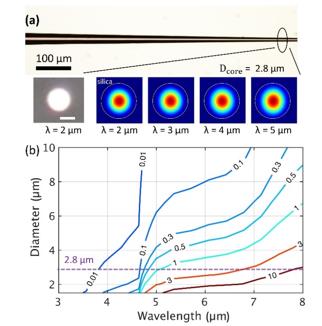Abstract: Recently, Nature publish group journal Light: Science & Applications (IF:14) published new advances of low-loss silicon core fibre platform. The paper is entitled " Low-loss silicon core fibre platform for mid-infrared nonlinear photonics ". This paper is jointly collaborated with Dr. Li Shen from Multi-Dimensional Photonics Lab, Wuhan National Laboratory for Optoelectronics, Huazhong University of Science, Prof. Anna Peacock from University of Southampton, Prof. John Ballato from Clemson University and Prof. Ursula Gibson from Norwegian University of Science and Technology.
Broadband mid-infrared light sources are highly desired for wide-ranging applications including medicine, food production, imaging, environmental monitoring, and security. To generate such a broad spectral bandwidth, supercontinuum (SC) sources based on extreme nonlinear phenomena have emerged as the most popular option. To date, non-silica soft glasses (e.g., chalcogenides, fluorides, or tellurites) has been used to generate SC sources. However, there are challenges when working with these materials, as they are not as stable or robust as their silica counterparts and, in the case of the chalcogenides, they often contain toxic compounds. Alternatively, planar-based SC systems employing highly nonlinear group IV materials (e.g., silicon) and compound III–V semiconductors can be used high efficient SC sources. However, the best demonstrations of SC generation in silicon-on-insulator (SOI) waveguides have so far been limited to wavelengths <3.3 μm, due to the propagation losses associated with increased core/cladding interactions.

Figure 1. (a) Microscopy image of a tapered SCF with varying core diameters. (b) Contour map showing simulated absorption losses for the SCFs in dB/mm as functions of wavelength and fibre core diameter.
Since 2010, the collaborated research group has been developing high performance silicon core fibre platform, which combines the benefits of fibre geometry with the advantages of semiconductor material systems. The fibre was fabricated by placing a silicon rod inside a silica glass capillary which is coated with calcium oxide and the composite structure is then heated and drawn into a fibre. Following drawing, the fibre was tapered so that core size decreased in size from 10 to 2 µm (Fig.1).

Figure 2. (a) Schematic of the asymmetric taper design. (b) Contour map of the GVD parameter as a function of the core diameter and wavelength of the SCFs. (c) Profile of the core diameter variation in the fabricated tapered fibre. (d) ZDW profile of the fabricated tapered SCF.
They design and demonstrate a compact silicon core, silica-clad waveguide platform that has low losses across the entire silicon transparency window. The waveguides are fabricated from a silicon core fibre that is tapered to engineer mode properties to ensure efficient nonlinear propagation in the core with minimal interaction of the mid-infrared light with the cladding (Fig2). When pumped with femtosecond pulses from an optical parametric oscillator at a wavelength of around 3 µm the tapered SCF emits broadband coherent light spanning two octaves (1.6–5.3 µm). The spectral broadening observed in the SCF represents the largest bandwidth generated in a silicon core/silica-clad waveguide to date, with the long wavelength edge being pushed well beyond the silica absorption edge. The low propagation loss of our tapered SCF (<1 dB/cm in the mid-IR region) enables a power conversion efficiency of ∼60% (Fig3).

Figure 3. (a) Experimental spectral broadening as a function of coupled average input power. (b) Simulated temporal evolution of the SC along the tapered fibre with a maximum coupled peak power of 1.19 kW. The colour bar shows the peak power in kW. (c) Simulated spectral evolution of the SC along the tapered fibre on a normalised logarithmic scale.
On November 21st, this work was published in Light: Science & Applications. Dr. Li Shen was the corresponding author. The work was supported by National Natural Science Foundation of China (NSFC) (61705072); the Engineering and Physical Sciences Research Council (EPSRC) (EP/P000940/1); the Norwegian Research Council (262232); and the J. E. Sirrine Foundation.
Reference: Ren, H., Shen, L., Runge, A.F.J. et al. Low-loss silicon core fibre platform for mid-infrared nonlinear photonics. Light Sci Appl 8, 105 (2019).
Paper website: https://www.nature.com/articles/s41377-019-0217-z